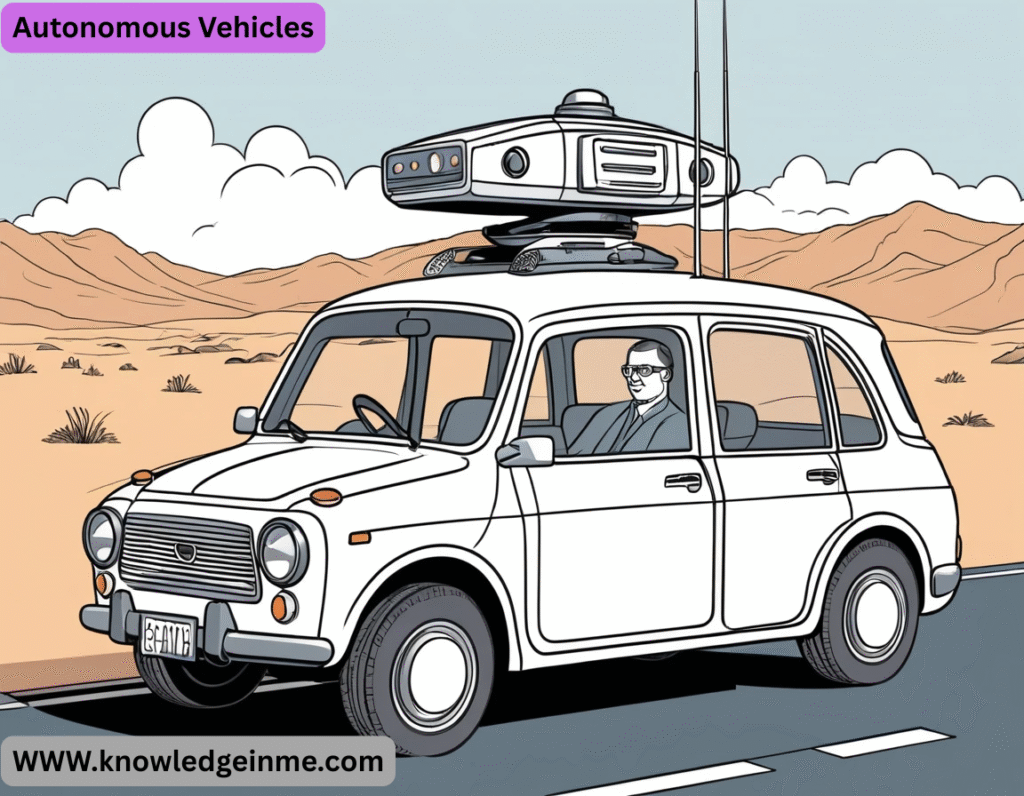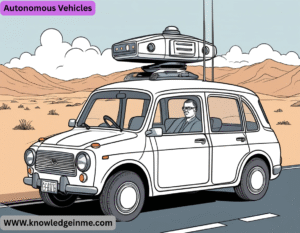Autonomous vehicles (AVs), also known as self-driving cars, are vehicles capable of sensing their environment and navigating without human input. They use a combination of sensors, artificial intelligence (AI), and advanced computing to interpret data and make driving decisions.
Levels of Autonomy SAE Classification
Level Name Description
0 No Automation Full human control (e.g., traditional cars)
2 Partial Automation Combined functions (e.g., Tesla Autopilot, GM Super Cruise), but driver must stay alert
3 Conditional Automation Car handles most tasks but may request human intervention (e.g., Mercedes Drive Pilot)
4 High Automation Fully autonomous in specific conditions (e.g., WAYMO taxis in geofenced areas)
Most AVs today are at Level 2 or 3, with some Level 4 vehicles in testing.
Key Technologies Behind AVs
Sensors & Perception
- Radar: Detects speed and distance of objects.
- Cameras: Provide visual data for object recognition (traffic signs, pedestrians).
- Ultrasonic Sensors: Help with parking and close-range detection.
AI & Machine Learning
- Neural networks process sensor data to identify objects, predict movements, and make decisions.
- Deep learning improves performance over time through real-world and simulated driving.
HD Mapping & GPS
- High-definition maps provide precise road details (lane markings, traffic signals).
- GPS helps with navigation but is supplemented by real-time sensor data.
- Vehicle-to-Everything (V2X) Communication
Benefits of Autonomous Vehicles
- Improved Safety – Over 90% of accidents are due to human error; AVs could drastically reduce crashes.
- Reduced Traffic Congestion – AI-optimized driving can improve traffic flow.
- Increased Mobility – Helps elderly and disabled individuals travel independently.
- Lower Emissions – Electric AVs could reduce pollution when paired with renewable energy.
- Cost Savings – Fewer accidents mean lower insurance and healthcare costs.
Challenges & Concerns
- Regulation & Liability – Who is responsible in an accident: the manufacturer, software developer, or passenger?
- Cybersecurity Risks – AVs could be hacked, leading to safety threats.
- High Development Costs – Building and testing AVs is expensive.
- Job Displacement – Truck, taxi, and delivery drivers may face job losses.
- Ethical Dilemmas – How should AVs prioritize decisions in unavoidable accidents?
Ethical Dilemmas in Autonomous Vehicles
The Trolley Problem for AVs
- One of the biggest philosophical challenges for AVs is how they should make life-or-death decisions. For example:
- If an accident is unavoidable, should the car prioritize the safety of its passengers or pedestrians?
- How should it choose between hitting a motorcyclist with a helmet vs. one without?
Current Approaches:
- Utilitarian AI (Minimize total harm) – The car would choose the option causing the least overall damage.
- Self-Preservation Logic – Some argue the car should protect its passengers at all costs.
- Randomized Decision-Making – To avoid bias, some suggest letting the AI make unpredictable choices.
Real-World Impact:
- Germany has proposed ethical guidelines for AVs, including:
- Human life must always be prioritized over property.
- No discrimination based on age, gender, or other factors.
How AVs Handle Bad Weather
- Bad weather (rain, snow, fog) is a major challenge because it interferes with sensors.
Problems in Adverse Conditions:
- LiDAR Issues – Heavy rain or snow can scatter laser beams, reducing accuracy.
- Camera Blindness – Fog or glare can obscure vision.
- Slippery Roads – AI must adjust braking and steering for icy conditions.
Solutions Being Developed:
- Advanced Sensor Fusion – Combining LiDAR, radar, and thermal cameras for redundancy.
- Machine Learning for Weather Adaptation – Training AI on diverse weather scenarios.
- HD Maps with Real-Time Updates – Helps the car “remember” road layouts even if sensors fail.
- V2X Communication – Traffic signals could warn AVs about black ice or flooding.
Example:
- WAYMO tests in rainy Phoenix and snowy Michigan to improve performance.
- Tesla uses neural networks to recognize obscured road markings.
Autonomous Trucks & Freight Transport
- Self-driving trucks could revolutionize logistics but face unique challenges.
Challenges:
- Regulatory Hurdles – Laws vary by country on unmanned freight.
- Public Acceptance – People may fear sharing highways with driverless big rigs.
- Last-Mile Problem – Human drivers may still be needed for complex urban deliveries.
Key Players:
- Tu Simple – Testing autonomous semi-trucks in the U.S. and China.
- Aurora – Partnered with Volvo and FedEx for self-driving freight.
Cybersecurity Risks & Hacking Threats
- Since AVs rely on software, they are vulnerable to cyberattacks.
Potential Threats:
- Remote Hijacking – Hackers could take control of steering/braking.
- Data Theft – Personal travel history could be stolen.
- Sensor Spoofing – Tricking LiDAR/cameras with fake signals (e.g., fake stop signs).
Countermeasures:
- Blockchain for Secure Updates – Prevents tampering with vehicle software.
- Encrypted V2X Communication – Secures car-to-car messaging.
Example Incident:
- In 2015, hackers remotely disabled a Jeep Cherokee’s brakes, leading to a 1.4 million-vehicle recall.
The Role of 5G in AV Development
Ultra-fast, low-latency 5G networks are critical for:
- Real-Time Data Sharing – Cars can communicate instantly with traffic systems.
- Edge Computing – Processing data locally reduces delays.
- Fleet Coordination – Self-driving taxis and trucks can optimize routes collectively.
Example:
- China is testing 5G-powered AV highways where cars share data to avoid congestion.
Public Perception & Trust in AVs
- Despite advancements, many people still don’t trust self-driving cars.
Surveys Show:
- Top Concerns: Software failures, hacking, and lack of human oversight.
Building Trust:
- Transparency – Companies like WAYMO publish safety reports.
- Gradual Adoption – Starting with Level 2-3 systems (e.g., Tesla Autopilot) eases users in.
- Regulation & Standards – Governments setting safety benchmarks increases confidence.
When Will Fully Autonomous Cars (Level 5) Arrive
- Most experts believe Level 5 AVs are still 10-20 years away due to:
- Technological Hurdles – Handling all edge cases (e.g., construction zones, erratic drivers).
- Legal & Insurance Frameworks – Laws need to adapt to liability questions.
- Infrastructure Readiness – Roads may need upgrades for optimal AV performance.
Predicted Timeline:
- 2025-2030: More Level 4 AVs in controlled areas (e.g., robot axis in cities).
- 2030-2040: Possible Level 5 in ideal conditions (good weather, mapped roads).
- The Brain of AVs: How AI Makes Real-Time Driving Decisions
Neural Networks in Action
Perception Stack:
- Convolutional Neural Networks (CNNs) process camera feeds to identify objects (e.g., “pedestrian crossing at 45°”).
- Recurrent Neural Networks (RNNs) predict trajectories (e.g., “cyclist likely to swerve left”).
Behavioral Planning:
- Reinforcement Learning trains AI via simulated near-misses (e.g., merging onto a highway with aggressive drivers).
- Multi-Agent Systems model interactions with human drivers (who often break rules).
Edge Cases That Baffle AI
- “Ghost Bicycles”: A bike painted on the road tricks the car into emergency braking.
- Police Hand Signals: AVs struggle to interpret a cop directing traffic during a power outage.
- Schrödinger’s Pedestrian: A person standing still near a crosswalk—are they waiting to cross or just chatting?
- Solution: Companies like WAYMO use “fuzz testing”—throwing millions of bizarre scenarios at the AI to harden it.
The Dirty Secret: AVs Still Struggle With
Left Turns Across Traffic
- Humans use intuition to gauge gaps in oncoming traffic; AVs rely on probabilistic models that can be overly cautious.
- Result: Some AVs avoid unprotected left turns altogether, rerouting to right turns only.






